What Is AI Roaming?
AI roaming is a roaming function on the basis of smart roaming. It improves link quality during STA roaming by improving roaming sensitivity so that signals for STAs are good during roaming. Additionally, AI roaming collects information, such as STA roaming thresholds and roaming steering policies, to generate roaming profiles for each type of STAs, thereby improving the roaming success rate and further enhancing STAs' roaming experience.
Issues of Traditional WLAN Roaming and Smart Roaming
Traditional WLAN Roaming
On a WLAN, users require mobile communication. The signal coverage of a single AP, however, is limited. As such, users often move from the coverage area of an AP to that of another AP. To prevent network interruptions while users move between different APs, the concept of WLAN roaming is introduced.
WLAN roaming is a process wherein a station (STA) — when moving to the boundaries between two APs — associates with the new AP and disconnects from the original AP, during which connections are not interrupted. Simply put, WLAN roaming is similar to cell handover for a mobile phone. When a mobile phone moves from the coverage area of a base station to that of another base station, the mobile phone still enjoys uninterrupted and seamless call experiences.
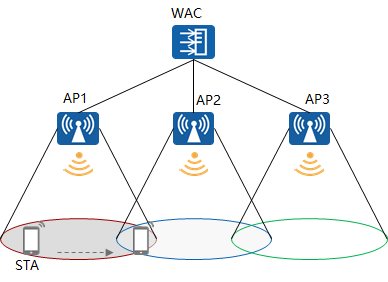
WLAN STA roaming
The STA roaming process typically includes the following phases:
- Triggering: After detecting that the downlink received signal strength indicator (RSSI) is lower than the threshold, a STA triggers the channel scanning process.
- Scanning: The STA actively or passively scans for available APs in its current location and measures network information used for network selection.
- Active scanning: The STA periodically sends a Probe Request frame. After receiving the frame, APs respond to the STA with a Probe Response frame. After receiving the Probe Response frame, the STA detects the existence of the APs.
- Passive scanning: The STA listens on Beacon frames periodically sent by APs to detect them.
The scanning mode is determined by the STA. The wireless network adapter of a mobile phone or computer supports both the active and passive scanning modes. Generally, Voice over Internet Protocol (VoIP) terminals use the passive scanning mode.
- Network selection: The STA selects an AP as the roaming target based on the scanned AP information.
- Handover: The STA selects a roaming mode that matches the network side based on the STA and network capabilities.
Currently, the following roaming handover modes are supported: common roaming, ast roaming using pairwise master key (PMK) caching, 802.11v roaming, and STA steering in deauthentication mode.
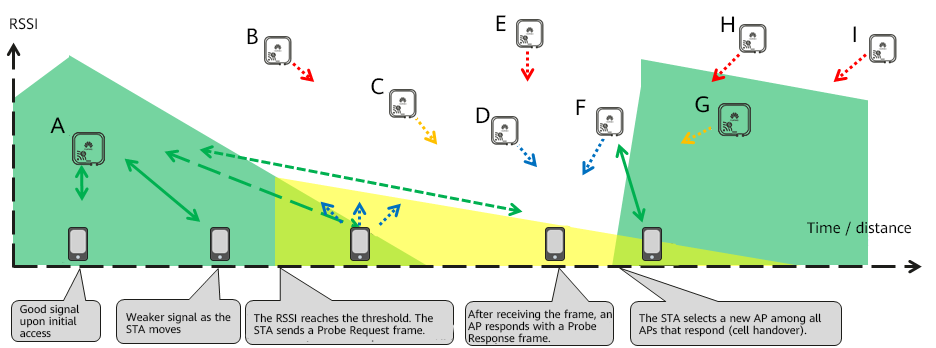
STA roaming process
Smart Roaming
According to the traditional WLAN roaming process, we can see that STA roaming is initiated by the STA itself. Therefore, this process is also called proactive STA roaming. However, some STAs have low roaming aggressiveness. As a result, they stick to the initially connected APs regardless of the long distance from the APs, weak signals, or low rates. The STAs do not roam to neighboring APs with better signals. They are called sticky STAs.
Proactive STA roaming cannot resolve the problem of sticky STAs. This is where smart roaming comes in. Smart roaming can steer STAs to roam in a way that STAs understand. Compared with proactive STA roaming, smart roaming is more intelligent.
What Problems Does Smart Roaming Have?
Currently, smart roaming is faced with the following problems:
- Triggering phase: The RSSI threshold for a STA to trigger roaming varies. However, STA roaming is steered on the network side typically by using a fixed RSSI threshold, without considering the RSSI threshold differences between STAs. The RSSI threshold for some STAs to trigger roaming is low. If the RSSI threshold falls below the fixed RSSI threshold on the network side, the service quality during roaming deteriorates severely.
Additionally, when a STA passes through an occluded area (for example, a corridor corner), the downlink RSSI of the AP with which the STA associates decreases sharply. In such a scenario, the STA triggers roaming based on this RSSI far lower than its expected roaming RSSI threshold. After the STA with a low RSSI goes through a series of roaming processes covering scanning, network selection, and handover, user experience is poor for a long time.
- Scanning phase: A STA with a low RSSI scans all channels, which greatly affects normal services. When the STA switches to another channel during scanning, it stays on the channel for a short period of time (varying according to the STA type). During this period of time, the STA performs scanning actively or passively to discover the APs that work on the same channel. In passive scanning mode, the STA may fail to scan the APs.
- Network selection phase: The uplink and downlink RSSIs are different, and the network side selects an optimal roaming target based on the uplink RSSI. Therefore, the AP selected on the network side may not be the optimal one for the STA. The handover condition differences between STAs are not considered on the network side, decreasing the roaming steering success rate.
The uplink RSSI is the strength of signals received by a STA from an AP. The downlink RSSI is the strength of signals received by an AP from a STA.
- Handover phase: The handover takes a long time, degrading user experience.
Why Do We Need AI Roaming?
- Triggering roaming in advance: STA roaming is triggered in advance. This prevents long-time poor user experience caused by roaming triggered when the RSSI decreases sharply, improving the STA roaming sensitivity.
- Coordinately scanning roaming neighbors (APs) and STAs: The downlink RSSI measurement capability of STAs and the coordinated scanning function (using a third independent scanning radio of the AP) are used to determine the motion status of STAs and predict possible roaming tracks of STAs in advance, reducing unnecessary roaming events.
- Identifying roaming behaviors of different types of STAs: Roaming profiles are created for different types of STAs. The conditions for successful roaming steering of a STA are learned for subsequent roaming steering of STAs of the same type, improving the success rate of STA roaming steering.
- Identifying the optimal roaming AP in advance: The optimal AP to which a STA can successfully roam is identified in advance based on the STA's location and roaming profile information, reducing the time for the AP handover.
Key Technologies of AI Roaming
STA Identification and Roaming Profile
STAs of different models use different Wi-Fi chips and WLAN module drivers, and therefore support different roaming steering modes. With the STA identification function, after a STA goes online, the AP identifies the STA type and reports the identification result and STA capability information to the AC or iMaster NCE-CampusInsight analyzer (CI analyzer for short). Based on the identification result, the AC or CI analyzer parses roaming behaviors of STAs, including the RSSI threshold for STA roaming, types of measurement frames (LM/TPC) that can be responded by STAs, and 802.11v-based steering conditions supported by STAs. Based on STA models, STA profiles are created.
After a new STA goes online, if a STA profile match is found, the AC or CI analyzer delivers the matching STA profile information to the AP. The AP then steers the terminal to roam accordingly. If no matching STA profile exists, no STA profile information is delivered. The AP trusts the roaming capability of the STA, steers the STA to roam based on the default roaming steering policy, and reports the steering process information as a sample to the AC or CI analyzer to generate a new STA profile. In this manner, the STA profile can be automatically learned online.
Optimal AP Identification and Roaming Steering
After a STA goes online, link measurement (mainly RSSI information) is continuously performed between the STA and its associated AP. The AP determines whether the STA is moving away from it based on the change of the measurement result.
If the STA is moving far away from its associated AP, the target AP to which the STA may roam triggers the coordinated scanning process and simulates the STA's associated AP to initiate link measurement with the STA. The STA then sends the measurement result to its currently associated AP.
The associated AP generates an AP coverage snapshot of the current STA location, identifies the optimal target AP to roam based on the coverage snapshot and the STA's roaming profile information, and finally steers the STA to roam.
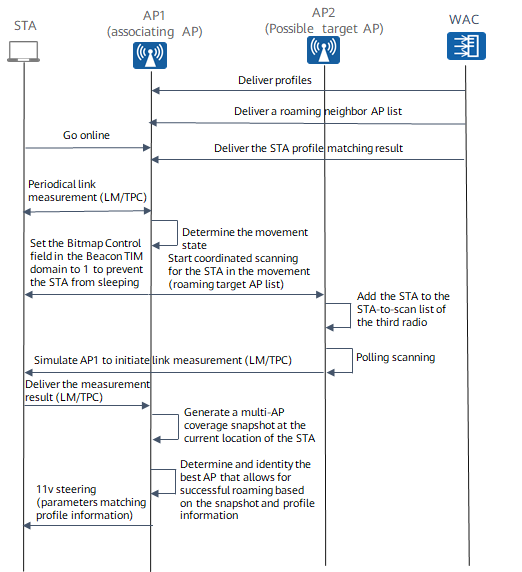
Optimal AP Identification and Roaming Steering
AI Roaming Application
Office Scenario Without Obstacles
In office scenarios without obstacles, APs are typically deployed in straight-line shaped or W-shaped mode. Both deployment modes can ensure continuous AP signal coverage and regular signal change during STA roaming. Therefore, AI roaming can be employed to proactively steer STA roaming on the network side to make STA roaming more proactive and timely. Moreover, the STA's RSSI is always within a good range during roaming.

Corridor scenario (line-shaped)

Open office area (W-shaped)
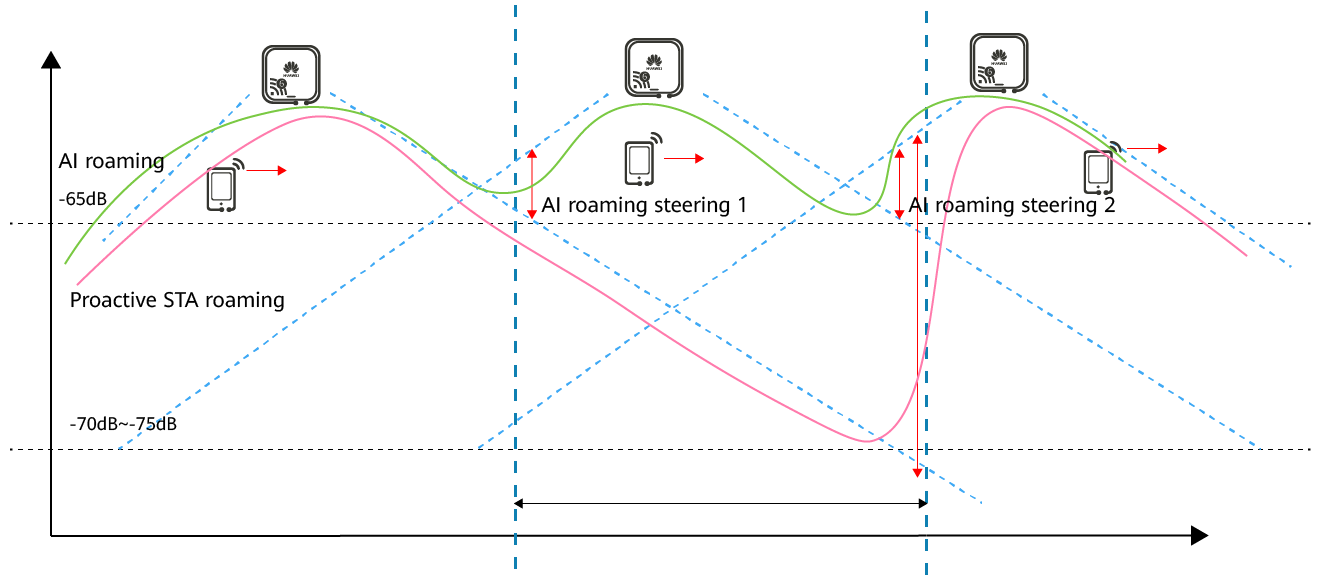
Proactive steering for AI roaming
Office Scenario with Obstacles
If the moving path where a STA passes through has obstacles or corners, the STA's RSSI decreases sharply as it moves until the STA roams to a new AP. During this period, the quality of the link between the STA and AP is poor, resulting in poor anti-interference capability and low STA speed as well as long-time transmission. In such a scenario, AI roaming helps predict the roaming track of a STA and triggers the roaming process in advance, thereby improving the roaming sensitivity and preventing service loss caused by late roaming.

Scenario with obstacles
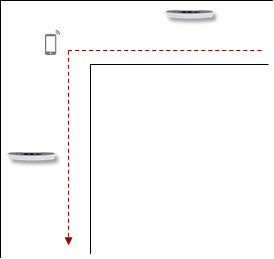
Corner
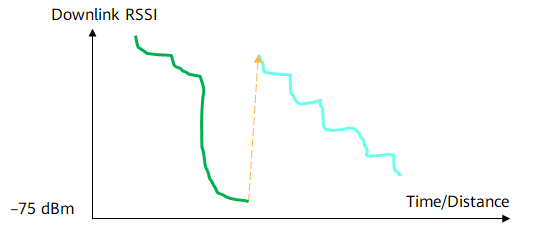
Sudden RSSI drop
Which APs Support AI Roaming?
The AI roaming function requires coordinated scanning of the third independent scanning radio on an AP. Therefore, the AI roaming function is available for AirEngine series APs that support three radios, such as AirEngine 5760-51, AirEngine 6760-X1, AirEngine 6760-X1E, AirEngine 8760-X1-PRO, AirEngine 8760R-X1E, AirEngine 6761-21T, and AirEngine 6761S-21T.
Note that the AI roaming function requires that STAs support link measurement (802.11k) or TPC measurement (802.11h) and roaming steering (802.11v).
For AI roaming capabilities supported by Huawei devices, see AirEngine Wi-Fi 6 products.
- Author: Han Jian
- Updated on: 2022-04-02
- Views: 6098
- Average rating:







